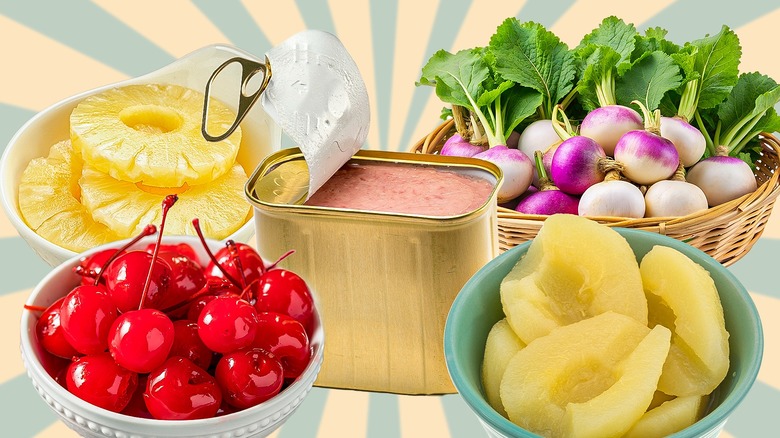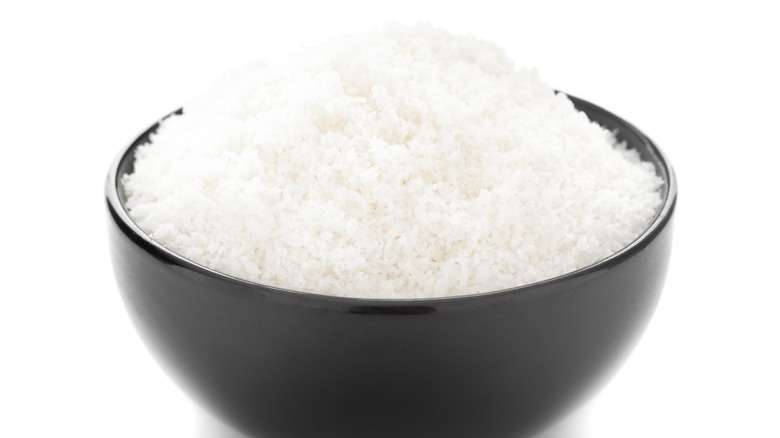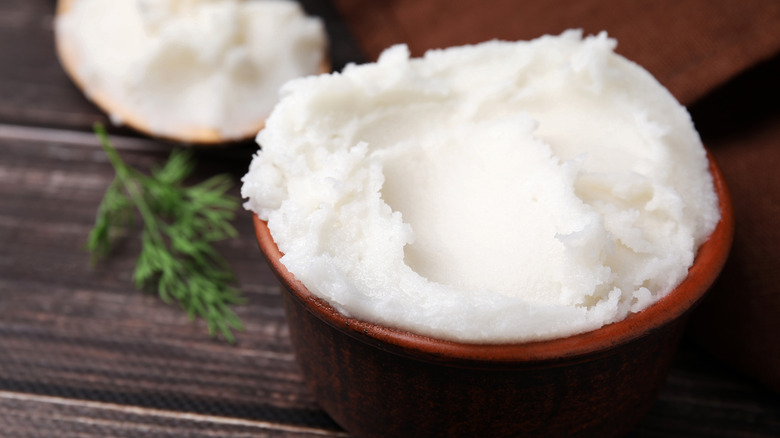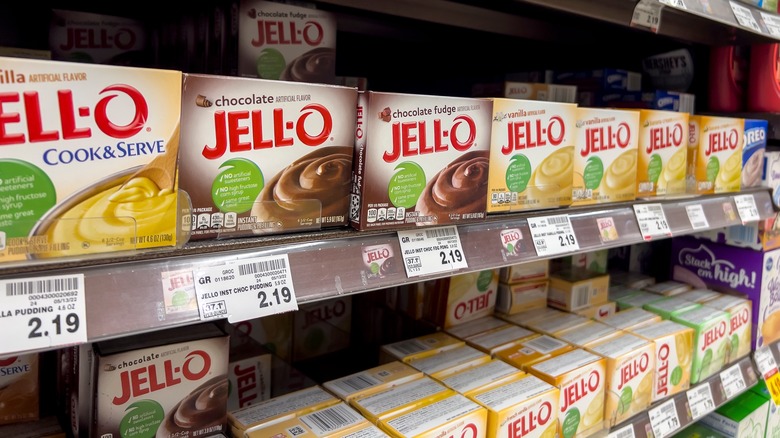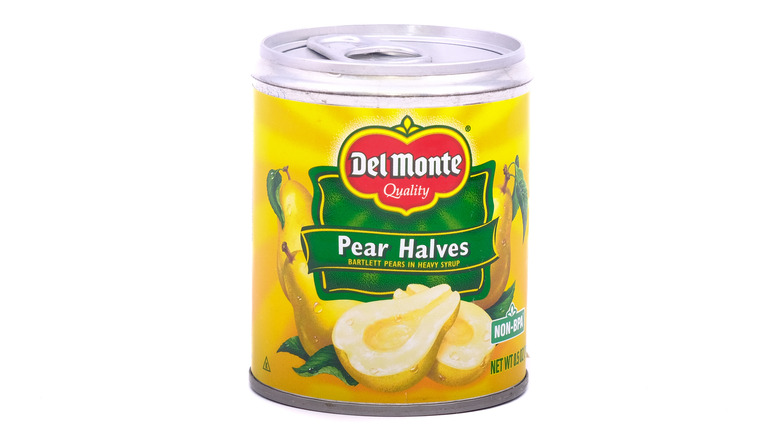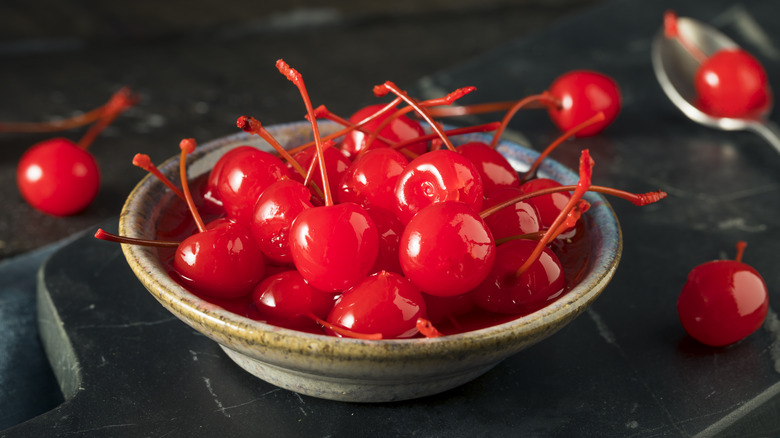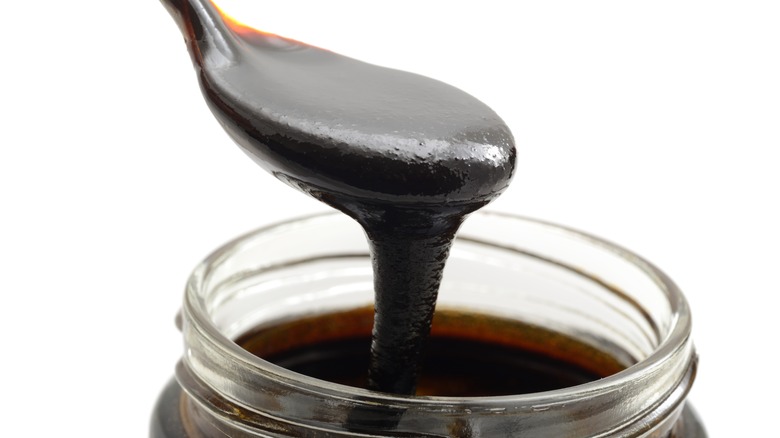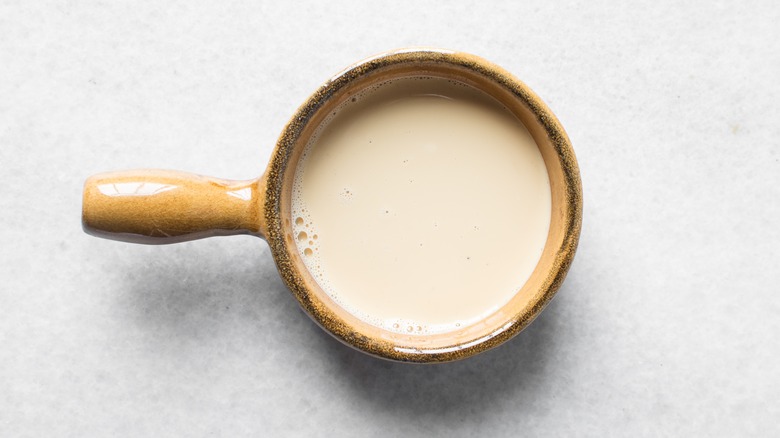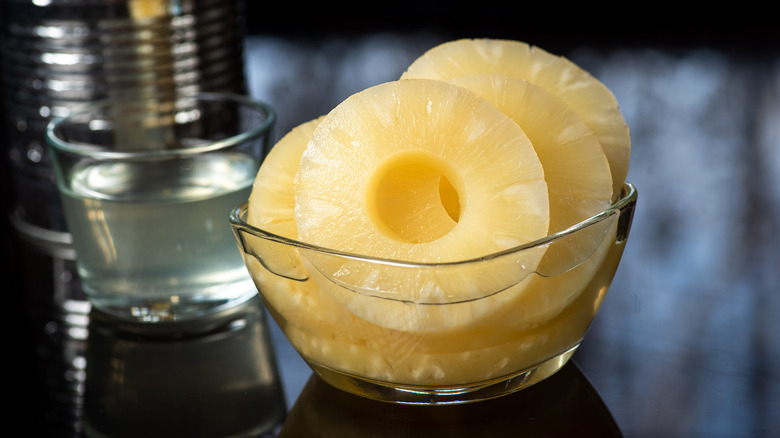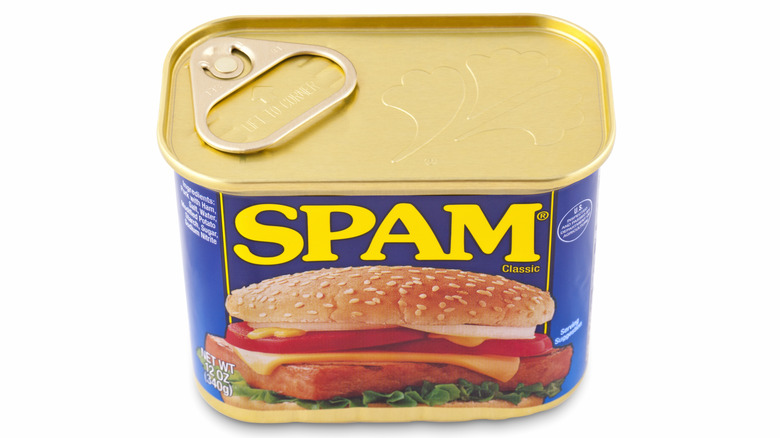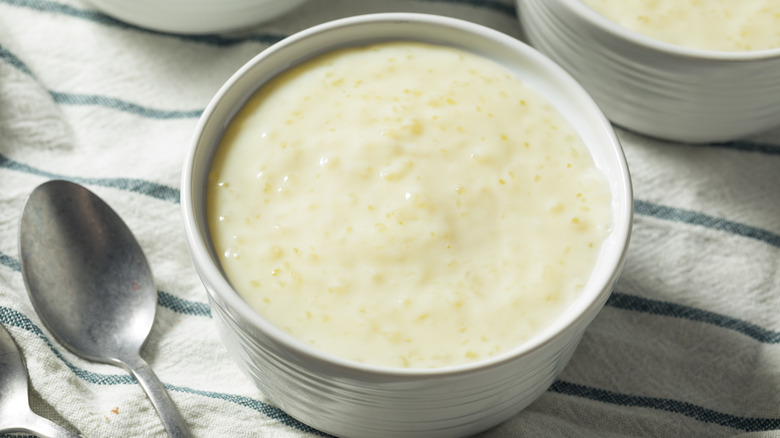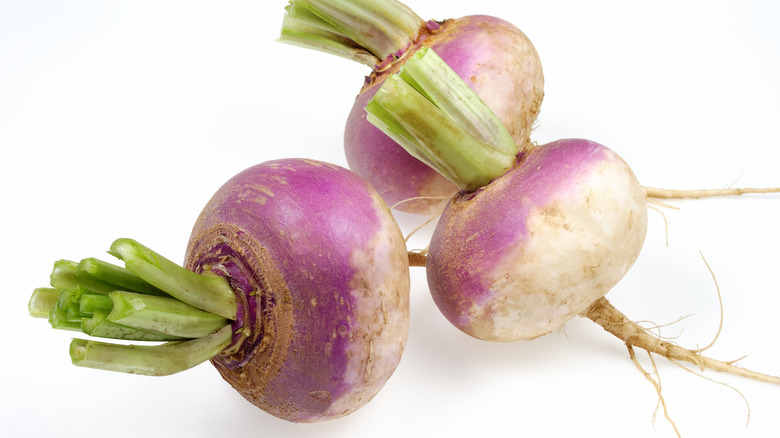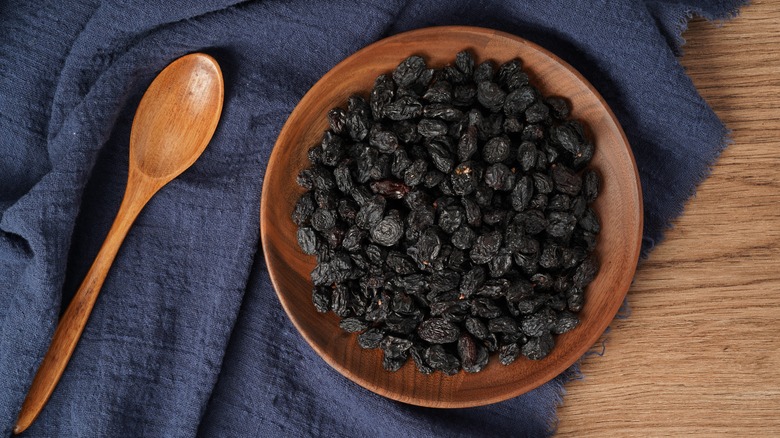Old School Ingredients Your Grandma Swore By (And Why You Should Too)
Food and health trends come and go, and the way we cook, bake, and eat, is constantly evolving. While some beloved family recipes are passed down through the generations unchanged, others sadly get lost. Sometimes, we overlook the humble ingredients that filled our grandmothers' pantries, dismissing them as old-fashioned or outdated. But in reality, these were key to countless hearty meals and bakes, and often some of the most economical, versatile, and flavor-packed foods.
In this article, we're taking a trip down memory lane, to rediscover the kitchen staples that our grandmothers swore by. All of these old school ingredients are still available in grocery stores today, and are brilliant for enhancing your retro recipes. They're firmly tried-and-tested and sure to evoke warm memories of grandma's cooking — you'll be surprised how seamlessly they can fit into modern cooking too.
From the comforting richness of lard to the sweet stickiness of maraschino cherries, there's a reason why these ingredients have prevailed through the decades. So, let's discover some of the many ways to put them to use. It's time to find those old recipe books and whip up some nostalgic favorites that we're certain will please taste-testers of all ages.
Desiccated coconut
Coconut is packed with creamy sweetness, making it amazing for adding texture and flavor to a range of recipes. If you thought that coconut products only came in the form of milk, cream, or flakes, think again. Desiccated coconut is an incredibly versatile staple to have on hand in your pantry, perfect for adding tropical deliciousness to cakes and bakes.
This ingredient is made by drying the pulp of the coconut and grinding it up into fine shreds. A true retro star, it arrived in the U.S. in the late 1800s, and has long been used in baking. Desiccated coconut brings a moist, chewy texture to cakes, cookies, and bars. Its finer texture makes it super easy to incorporate into mixes and batters, and ensures all of that coconut flavor is evenly distributed throughout the whole bake.
One old school favorite featuring desiccated coconut is coconut ice. In this simple recipe, the coconut is boiled with milk, sugar, and a drop of pink food coloring. Then, you simply press the mixture into a baking pan and allow it to set before slicing it up into coconutty slabs of goodness. Another classic is coconut macaroons — bite-sized, chocolate-coated cookies where desiccated coconut is the star of the show. Here, the coconut is folded into a mixture of egg whites, sugar, vanilla extract, and almond extract. Then, the mixture is squashed into balls, cooled, and dipped in dark chocolate. Yum!
Lard
In the 19th century, lard was the fat of choice for making all kinds of sweet and savory recipes. This rendered pork fat is rich, creamy, and flavorful, but in more recent times, lard has become far less popular. Though still available today, lard is now overshadowed by other forms of fat, like butter and vegetable oils.
The drastic decline in the use of lard is in part due to claims surrounding its negative health impacts. While it's true that lard is relatively high in saturated fat, which can increase the risk of developing heart disease if consumed in excess, butter actually contains more of this form of fat. Furthermore, lard has a greater amount of heart-healthy monounsaturated fat than butter. So, lard certainly shouldn't be cast aside for health reasons alone.
Lard still deserves a place in our cooking today. This fat has a relatively high smoke point of 370 degrees Fahrenheit, which makes it ideal for frying and roasting. In baking, lard is prized for its ability to create flaky, tender pastries, with many traditional pie crust recipes consisting of a simple mixture of lard, flour, and water. Old-fashioned lard biscuits are also a classic recipe that's certainly worth trying, which involves cutting the fat into the flour before adding buttermilk for a moist and flavorful result.
Instant pudding mix
Instant pudding mix is an ingredient that has stood the test of time, first entering the market back in 1918, and it's still sitting in many of our pantries today.
This much-loved dessert mix transforms into a delicious, creamy treat with the addition of just a little milk. It comes in a range of flavors, such as vanilla, chocolate, and pistachio, and is great for incorporating into simple, no-bake desserts like puddings, trifles, pies, and cake frostings. With its ease of use and versatility, it's clear to see why instant pudding has been a household favorite for decades.
One recipe that has its origins in generations gone by is banana pudding. This sweet and creamy dessert makes the most of simple, ready-to-use ingredients. First, vanilla instant pudding mix is prepared with sweetened condensed milk, water and Cool Whip, rather than the usual milk. Then, the pudding is layered up with sliced fresh banana and Nilla wafers in a trifle dish. The result is an impressive-looking layered dessert that's perfect for serving to guests.
There are so many other delicious and creative ways to use instant pudding, from incorporating it into cinnamon rolls, to making milkshakes extra smooth and creamy. It makes the perfect addition to a fresh fruit salad, too. We hope this one will still be kicking around for centuries to come.
Canned pears
Canned fruit is an ingredient most of us are probably used to seeing on supermarket shelves, but how often are you reaching for it in your recipes? Well, with its long shelf life, handy pre-prepared form, and nutritious qualities, stocking up on canned fruit is a pretty great idea. One of our favorites for making nostalgic desserts are canned pears.
Canned pears are a pantry staple your grandma likely had on hand. They're sweet and succulent, already peeled, and perfectly ripe, so typically need very little prep. The pears are usually preserved in either syrup or juice, which is great for adding a little extra sweetness to your recipes too.
An old school recipe in which canned pears are the shining star is pear and sultana cake. A sweet and spicy fruit filling is sandwiched between two layers of cake batter before baking, resulting in a crumbly, pear-loaded cake that screams nostalgia. Canned pears also make a wonderfully convenient addition to pies, tarts, and cobblers. They can also serve as a satisfying dessert as they are, or perhaps with a dollop of whipped cream. You could even try incorporating pears into savory recipes, such as an indulgent pear and gorgonzola pasta, or a crunchy pear and walnut salad.
Maraschino cherries
Another fruity ingredient that brings the retro vibes is the vibrant maraschino cherry. These sweet red jewels are commonly found adorning cocktails and desserts, and they've been enhancing recipes since the early 1900s.
The process of making maraschino cherries is a little more complex than you might think. First, the whole cherries are soaked in a brine, which strips them of their color and flavor. After six weeks, the cherries start their second soaking, this time in a mixture of sugar syrup, red dye, and flavoring, before being pitted and sometimes de-stemmed. Finally, the cherries and syrup are transferred to jars, forming the traditional maraschino cherries we see on shelves today.
These bite-sized and mouth-wateringly sweet preserved fruits are brilliant for adding a pop of color to your recipes. Try dropping a maraschino into a classic Manhattan, amaretto sour, or piña colada cocktail. You might have fond memories of your grandma baking these cherries into a fruit cake, or perhaps using them to top a retro pineapple upside-down cake. And of course, no ice cream sundae is completely without a glossy maraschino cherry perching on top.
Molasses
An ingredient that's been a staple in our kitchen for centuries, molasses is a thick, dark syrup with a rich flavor that's both sweet and slightly bitter. Molasses is a by-product formed during the sugar making process, and it's thought to have first been produced in 500 BC. Before the widespread availability of refined sugar, molasses was the go-to sweetener for many.
Molasses is a popular ingredient for adding sweetness, color, and a unique depth of flavor to old-fashioned baked goods, as well as savory recipes. One of the most famous uses for this sweetener is in gingerbread cookies, where its deep flavor pairs perfectly with spices like ginger and cinnamon. Molasses is also a key ingredient in traditional Boston baked beans, where it adds a wonderful sweet and smoky richness.
This unique ingredient also has some surprising potential health benefits. While refined sugar offers very little in the way of nutrition, molasses is high in many vitamins and minerals. It's an excellent source of magnesium and potassium, which play a key part in heart health, as well as iron and calcium, which we need for healthy blood cells and bones. Molasses is also rich in antioxidants, which can protect us against oxidative stress and reduce the risk of developing certain diseases. Of course, it should still be consumed in moderation.
Evaporated milk
Evaporated milk is an old school ingredient — sometimes referred to as unsweetened condensed milk — that's known for its rich, creamy texture. Coming in convenient canned form, it has a long shelf life, which makes it the perfect pantry staple for adding to everything from soups and sauces to decadent desserts.
Not to be confused with sweetened condensed milk, which has a high sugar content and a much thicker, stickier texture, evaporated milk is runnier and more pourable. It's also not sweetened. First developed in the late 19th century, evaporated milk is made by heating milk to remove over half of its water content. Once firmly sealed in a can, there's no need to refrigerate the milk, and it can be stored in your pantry for up to two years.
Rice pudding, a recipe that's been enjoyed by multiple generations of foodies, typically combines evaporated milk with fresh whole milk, sugar, eggs, vanilla, and rice. This glorious mixture is simmered or baked until the rice is tender and creamy, creating the most comforting of desserts. Evaporated milk is also commonly used to make fudge, alongside butter, sugar, and vanilla. It helps to give the fudge a rich and creamy texture, without making it overly sweet. Evaporated milk has its place in savory recipes too. It can be used to add a wonderful silkiness to dishes like macaroni and cheese, as well as chicken soup, and mashed potatoes.
Pineapple rings
If you've ever whipped up a moist and syrupy pineapple upside-down cake, you've probably used these beauties. Pineapple rings are juicy, tangy, and come conveniently canned and ready to use. These vibrant fruits are brilliant for adding a burst of tropical flavor to a variety of dishes.
The pineapple upside-down cake, with its moist sponge and distinctive sticky pineapple and cherry topping, first rose to fame in the 1920s. It was the cake of the moment, with pineapple deemed a particularly trendy ingredient at this time. Utilizing pineapple in canned form — that had already been neatly cut into rings — was the perfect way to simplify this fruity bake, and this recipe still remains popular today.
Pineapple rings are also great for adding some balancing sweetness to savory dishes. They can be used to top a ham before roasting, or a pizza before baking – although their use on the latter is considered by some as a controversial pizza topping. Pineapple is also perfect for throwing into salads for some extra tang, or garnishing a cocktail for a tropical twist. Ultimately, the pre-cut rings can save you heaps of time removing the crown, rind, and core from a whole pineapple, so toss them into any recipe that calls for this juicy fruit and thank us later.
Spam
Love it or hate it, there's no questioning that Spam is a true old school ingredient. This iconic pre-cooked meat product contains a mixture of ground pork and ham, along with salt, sugar, and preservatives, which is then vacuum-sealed in a can. Spam first became available in 1937, and was used to feed soldiers during World War II due to its convenient canned nature. It was after the war that Spam's popularity as an everyday foodstuff sky-rocketed, and by 1959, sales had reached a staggering 1 billion cans.
Spam has long been used in a wide variety of dishes, versatile enough to be enjoyed as part of a breakfast, lunch, or dinner. A popular way to prepare Spam is pan-frying it, heating it through and giving it a lightly browned exterior. Making a classic Spam sandwich involves filling the bread with the fried meat, alongside a fried egg and some slices of cheese. Spam fritters are another nostalgic recipe that involves dipping slices of Spam into a flour and water batter, and deep-frying them until crisp.
To give Spam an Asian-inspired twist, Spam musubi is a fun recipe to try. First, you'll need to fry the Spam in a little oil until browned. Then, add some sugar, water, and soy sauce to the pan to coat the meat, and let everything simmer for a few minutes. To assemble the musubi, top the Spam with some sticky sushi rice, and wrap everything in a strip of nori seaweed.
Tapioca
If you mention tapioca to anyone who was at school during the '50s and '60s — particularly in the U.K. — you'll likely be met with tales of a less-than-appetizing, slimy dessert, often likened to frogspawn. Tapioca pudding was a staple on the school lunch menu for many, typically served with a dollop of jam.
Tapioca is a form of starch that comes from the cassava root, and it's available in the form of either flour, flakes, or pearls. Tapioca pearls are the variety that feature in the classic tapioca pudding, where they're combined with milk, eggs, sugar, and vanilla. However, if you're still traumatized by memories of a slimy school pudding, there are plenty of other more appetizing ways to incorporate tapioca into your cooking and baking. The flour can be a valuable addition to baked goods such as brownies and cookies, bringing a crisp, chewy texture and serving as a brilliant gluten-free alternative to traditional all-purpose flour. It's also used as a thickener in savory recipes like soups, stews, and gravies.
In recent years, tapioca has had a resurgence of popularity, particularly with the rise of bubble tea. This Taiwanese beverage makes use of large, chewy tapioca pearls, called boba, which are added to the mixture of milk, fruit juices, and tea. Thanks to this trendy drink, tapioca now has a new generation of fans around the world.
Turnips
Let's face it, turnips probably aren't up there with the nation's favorite veggies. But, these humble root vegetables are a reliable and nutritious ingredient that's been around for thousands of years. In fact, records show that turnips were an important part of the diet for the ancient Greeks and Romans, so use of this vegetable extends a little further back than your grandma's generation.
Turnips have a crisp texture and peppery flavor that's both sweet and a little bitter. While they can be eaten raw, most turnip recipes involve cooking the vegetable in some way. In generations gone by, they were often used in soups and stews, adding heartiness and sustenance to the broth. Another delicious way to enjoy turnips is transforming them into a potato and turnip mash. Simply boil the peeled and diced turnips along with the potatoes, before mashing with milk, butter, and herbs. The leaves, known as turnip greens, are also edible, and these can be sautéed, lightly simmered in a broth, or enjoyed raw in a fresh salad.
These vegetables are also highly nutritious. Turnips are rich in vitamins C and A, which help to keep our immune system healthy, as well as potassium, which is essential for healthy nerve function and keeping blood pressure in check.
Currants
Currants are small, chewy, dried fruits, with a distinctive tart yet sweet flavor. They're incredibly versatile and will stay fresh in the pantry for long time periods, so they're perfect to keep on hand for all of your baking needs.
Typically made from a small variety of grapes of the Black Corinth' or Carina varieties, currants are produced by drying the fruits for several weeks to remove most of the water content. This makes their flavor much more concentrated than that of a fresh grape. Currants are closely related to raisins and sultanas, which are produced in a similar way using different varieties of grape, though currants tend to have the strongest taste.
Traditional recipes like fruit cakes, scones, and mince pies often feature currants, where their rich, tangy sweetness adds plenty of depth to the bakes. Currants are still widely available today, and they're fantastic for mixing into homemade muffins, cookies, or bread. Or, for a savory option, they will complement meat brilliantly, providing a balancing fruitiness to the rich, hearty flavors of beef, lamb, or chicken. Currants also make an amazing stuffing when combined with onions and chestnuts. You can even toss them into salads, to add a unique element of tart flavor and chewy texture.
